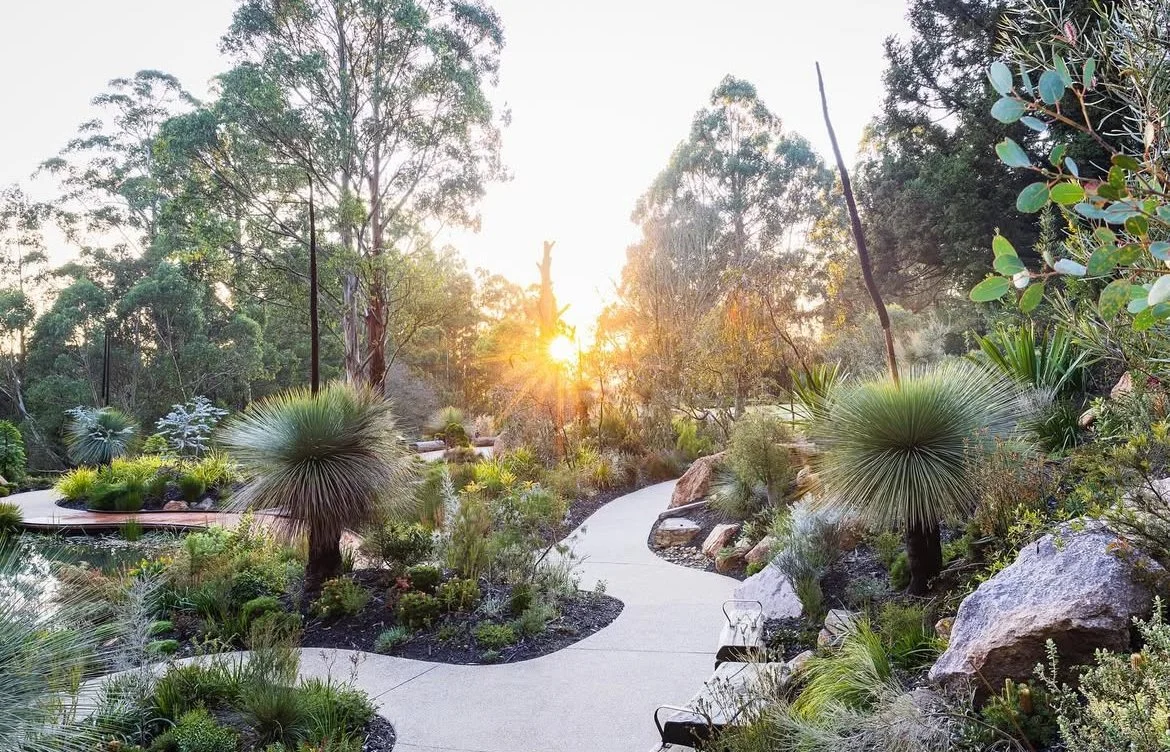Still Places #10 : Something of Our Own
All Text & Images: Dom Galloway | GardenSpace (unless otherwise noted)
For a long time, Australian gardens bore the weight of other worlds. The first settlers, uncertain of their new continent, tried to recreate the landscapes they had left behind. Gravel paths around manicured lawns, beds of roses, stands of poplars, elms and oaks—all imported attempts to soften a land that seemed, at first, wild, harsh and alien. The garden became a place of reassurance, a way to make the unfamiliar look familiar. Yet behind these planted facades lay a continent with its own immense botanical wealth, its own rhythms of drought, flood, and fire, and its own languages of shade, scent, and form.
In recent decades, a shift has been taking place. Out of this wide continent a garden style has begun to emerge that feels recognisably, even proudly, Australian. It is not simply the planting of eucalypts and kangaroo paws, nor the scattering of gravel and boulders. It is an attitude—an acceptance of the land as it is, and a willingness to work with, rather than against, its character. Where once the garden was a defence against climate, now it increasingly becomes an expression of climate. Shaded courtyards open to cooling breezes. Grasses ripple in summer heat. Plants flower in winter, scent the air after rain, and endure long spells of dryness.
Chelsea Australian Garden at Olinda Image Credit: Phillip Johnson
Such gardens have a distinctive presence. There is a quiet power in the muted greys, greens and silvers of foliage, providing a strength to the sudden blaze of colour seen in wattles, grevilleas or bottlebrush in spring. They embrace asymmetry, irregularity, and open space, reflecting the natural bush more than the clipped formality of European tradition. Stone, timber, and rusted steel feel at home here, echoing the textures of a continent worn by sun and time. Water is no longer spread in wide, thirsty lawns, but gathered carefully in pools, tanks, and billabong-like hollows—precious, seasonal, and alive with reflection.
“We must feel part of the land we walk on and love the plants that grow here if we are to achieve spirit in a garden” - Gordon Ford
The emergence of this style raises a deeper question: are we, at last, beginning to feel ourselves part of the land we walk on? For two centuries the Australian relationship with landscape has often been uneasy. The bush was feared as much as loved. Fire was seen as catastrophe rather than cycle. The garden was a place to retreat to, not a place to listen to the continent’s voice. But as the years pass, and as generations grow up knowing no other home, something shifts. The colours, scents, and shapes of Australian plants begin to feel like home themselves.
Designers and gardeners alike are learning to read the land. They look at how shade falls in a summer afternoon, how soil holds or sheds water, how the local trees frame the sky. The best gardens are less imposed on a site, rather grown from it, as if they had always belonged there. This recognition—that the land itself has something to teach us—marks a quiet but profound step towards belonging.
In this, the Australian garden becomes more than a collection of plants. It becomes an expression of identity. To plant local plants is to declare an affinity with a site and its soil. To welcome the screech of cockatoos, the flash of parrots, the hum of native bees, is to weave the garden into the life of the continent. Even the acceptance of impermanence—the knowledge that drought, flood, or fire may alter a garden—reflects a deeper recognition and understanding of the realities of this place.
There is, of course, no single model. The Australian garden is not a rigid stylebook, but a spirit of approach. In coastal towns, it may take the form of wind-sculpted shrubs, hardy succulents, and shaded decks. In arid interiors, it may be a courtyard of sand, stone, and saltbush, alive at dusk. In cities, it may be a careful weaving of native planting with productive gardens for food, a recognition that culture and nature are not opposed. The common thread is a willingness to work with what is here, not against it.
Perhaps this is what belonging is: not grand impositions, but subtle choices that sit easily in a site—what to plant, what to preserve, how to shape space for rest and shade. These gardens may be the quiet beginnings of a broader reconciliation with land and place. They are not yet a finished expression, but they are unmistakably ours. Something of our own, grown from the soil beneath our feet, shaped by our climate, and alive with the character of this continent.
For more:
• RBGV Cranbourne Gardens, (https://www.rbg.vic.gov.au/cranbourne-gardens/)
• Chelsea Australian Garden at Olinda, (http://www.chelseaaustraliangardenatolinda.com.au)
We would love to help embrace this new appreciation for our native environments in your garden ideas, contact us today.


